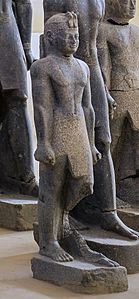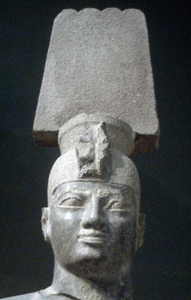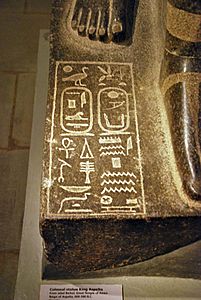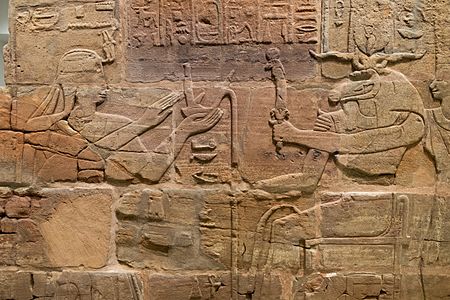Aspelta facts for kids
Quick facts for kids Aspelta |
|||||
|---|---|---|---|---|---|
| Kushite King of Napata | |||||
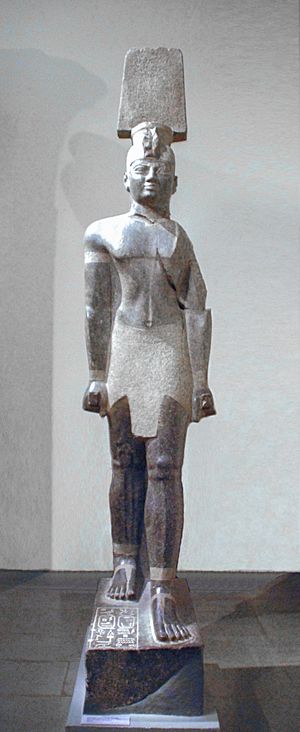
Colossal statue of King Aspelta from Jebel Barkal, Boston Museum of Fine Arts.
|
|||||
| Predecessor | Anlamani | ||||
| Successor | Aramatle-qo | ||||
| Died | c. 580 BCE | ||||
| Burial | Nuri (Nu. 8) | ||||
| Spouse | Mediken?, Henuttakhebit possibly , Weqemale, Arsata and Artaha |
||||
| Issue | Aramatle-qo, Queen Amanitakaye | ||||
|
|||||
| Father | Senkamanisken ? | ||||
| Mother | Nasalsa | ||||
Aspelta was an important king who ruled the ancient kingdom of Kush from about 600 to 580 BCE. Kush was a powerful kingdom located south of Egypt, in what is now Sudan. We know a lot about King Aspelta because many stone carvings, called stelae, tell us about his life and what happened during his time as ruler.
Contents
Aspelta's Family and Royal Titles
Aspelta was the son of King Senkamanisken and Queen Nasalsa. He became king after his brother, Anlamani. King Aspelta had several wives, including Henuttakhebit, Weqemale, Asata, and Artaha. He might have also married his sister, Madiqen.
Aspelta used special titles, just like the Egyptian Pharaohs. These titles showed his power and connection to the gods:
- Horus name: Neferkha ("Whose Appearances are Beautiful")
- Nebty Name: Neferkha ("Whose Appearances are Beautiful")
- Golden Horus Name: Userib ("Whose heart is strong")
- Prenomen: Merykare ("Re is one whose ka is loved")
- Nomen: Aspelta
Aspelta's Time as King
When it was time to choose a new king, Aspelta was picked by a group of twenty-four important religious and military leaders. After this selection, he traveled north to Napata. There, he was officially chosen by the gods and crowned as king in a special ceremony.
One stone carving from Aspelta's reign tells a story about a group of priests. These priests faced serious consequences, likely for planning against the king.
Around 592 BCE, the kingdom of Kush was attacked by an Egyptian army. This attack was ordered by the Egyptian Pharaoh Psamtik II. Some historians believe Psamtik II might have seen Aspelta as a threat to his power in Upper Egypt, which was close to Kush. The Egyptian invaders badly damaged Napata, the capital city of Kush. Because of this attack, some historians think Aspelta decided to move the capital to a safer city called Meroë.
Aspelta's Burial Place
Aspelta's tomb is located in Nuri, and it is the second largest burial structure there. An archaeologist named George A. Reisner explored his tomb in 1916. Many valuable items were found inside, and most of them are now kept at the Museum of Fine Arts, Boston in Boston. The palace that Aspelta and his brother built was also explored by Reisner in 1920.
Discoveries from Aspelta's Reign
Many objects and monuments mention King Aspelta, helping us learn about his time. Here are a few examples:
- Two special plaques with Aspelta's name were found at Temple A in Kawa.
- Pieces of a large stone slab (stela) mentioning Aspelta were found at Temple T in Kawa.
- A wall carving shows King Aspelta offering a symbol of truth (Ma'at) to the ram-headed god Amun-Re and the goddess Anukis-Nethy.
- A shrine dedicated to Aspelta was discovered at a temple in Sanam.
- A stela from Aspelta's first year as king shows his mother, Queen Nasalsa.
- Another stela from his third year talks about his wife, Henuttakhebit, becoming a priestess.
- A large statue of Aspelta is now in the Boston Museum.
- His tomb (Nuri 8) contained many treasures, including gold and silver vases, and inscribed jars.
Artifacts
-
Sandstone wall of King Aspelta offering Ma'at (Truth) to ram-headed god Amun-Re accompanied by Anukis, Temple T at Kawa. Ashmolean Museum I9J2.I295.
See also
 In Spanish: Aspelta para niños
In Spanish: Aspelta para niños


